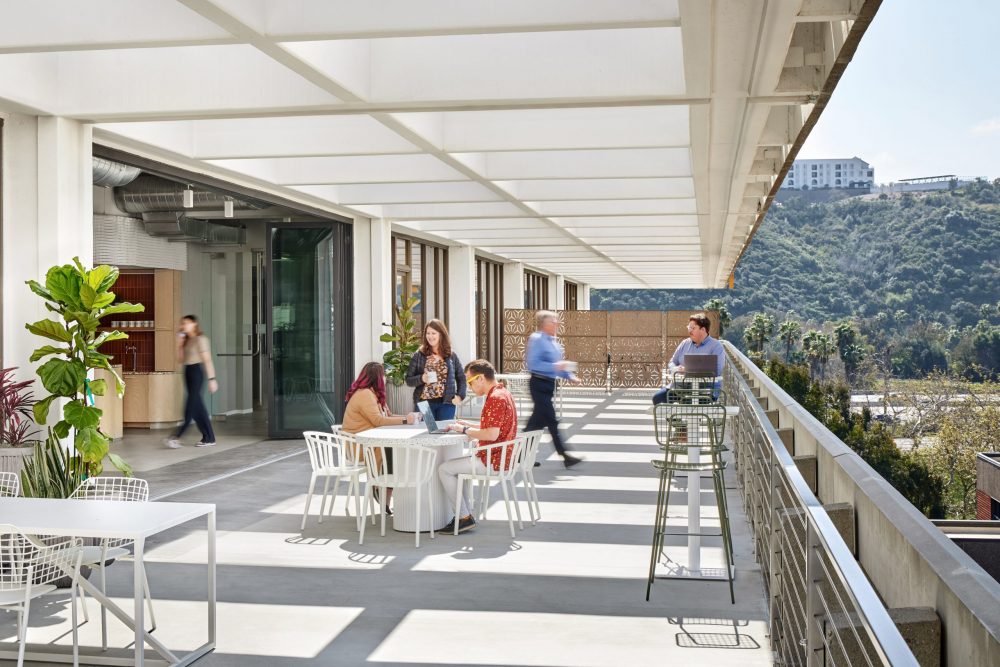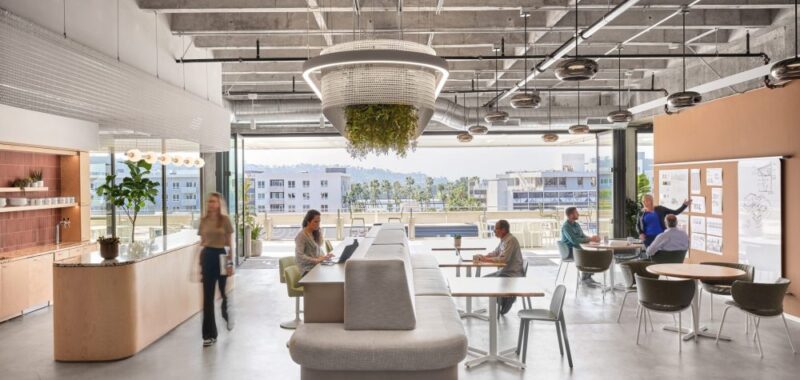HED’s Daniel Jaconetti and Rebecca Swanner offer some strategies for a sustainable and climate-conscious workplace.
The benefits of workplace sustainability are well established, with the impact of climate-conscious operations on both driving sales and attracting and retaining talent. In fact, a recent study found that 67% of respondents are more willing to apply for jobs with environmentally sustainable companies, and roughly one-third of those who had changed jobs in the past year had accepted a lower salary to work for a sustainable organization.
Because of the increasing frequency of climate-related disasters and disruptions, the sustainability conversation today is rightfully focused on reducing carbon footprint / greenhouse gas (GHG) emissions. However, for a leased office space, those factors often fall outside a company’s control and there are other impactful strategies that can be used to increase sustainability. For example, the designers of new leased office fit-outs in existing buildings often cannot alter the existing base-building mechanical systems or exterior envelope which may be inefficient. While they can make sure the systems within the new suite are as efficient as possible, and design around interior materials with lower embodied carbon, it’s typically mathematically impossible to achieve whole carbon neutrality without purchasing carbon credits/offsets.
Clearly there’s an imperative for all business owners to reduce their carbon footprint but GHG reduction / decarbonization aren’t the only sustainability goals that matter in workplace design. There are many other smart strategies companies can deploy to create a healthy, climate-aligned workplace that meets their Environmental, Sustainability & Governance (ESG) goals and their employees’ needs.
Start with Climate-Integrated Design
Creating a sustainable workspace is a multi-dimensional challenge, which greatly benefits from an integrated design model that includes cross-functional expertise that infuses eco-consciousness into the project’s DNA, impacting aesthetics, infrastructure, materials, and utilization.
Also, sustainability must be considered beyond the design, including in the budget, schedule, sourcing, and operations so you need stakeholders such as the owner, office manager and construction manager at the table from the start. Even if the goal does not include achieving a sustainability certification (i.e. LEED or WELL), having an inclusive perspective can help companies make smart, intrinsically occupant-health-centric decisions every step of the way.
Democratize Input
Before making decisions, consider the various roles and personas in the organization that will be impacted. The flooring material you choose could change the cleaning process for the custodian, for example, and the logistics required to participate in a composting program should be influenced by the janitorial staff and office manager.
While these factors may not change a decision, organizations will benefit from hearing and considering the viewpoints of every stakeholder. Justice, equity, diversity, and inclusion (J.E.D.I.) are as intrinsic to ESG metrics as energy efficiency, and everyone deserves to be heard. Not to mention, inclusion is extremely valuable for collaboration. The best ideas often come from unexpected places.
Prioritize the Human Experience
Physical, mental, and emotional well-being are essential to a productive workplace. Making spaces more inviting, livable, and uplifting will enhance utilization and employee happiness. In the new normal of hybrid work, creating a flexible, comfortable space is essential. For example, providing options for varying work posture and settings, such as standing desks, soft seating with side-tables, banquette style seating in a lounge-like space, entices people to come into the office, which supports collaboration, engagement, and team bonding.
It’s also vital for recruiting and retention. Over 90% of office workers say their jobs feel more secure in an environmentally friendly office, compared to 67% in those that aren’t. A sustainable workspace is more important than an annual bonus for modern workers, and it’s especially critical for Gen Z: 35% of workers ages 18-29 would consider leaving their employer if the company wasn’t clearly committed to sustainability.

Ground the Space in the Place
A regionally inspired material palette that captures the essence of the local context and culture can make for a more interesting work environment and also reduce the cost and carbon footprint by limiting transportation distance of elements during construction.
Using local stone and wood finishes, including salvaged or sustainably reused materials, infuses reverence for the local aesthetic—such as the coastal/urban color palette used for HED’s new San Diego office or employing a Southwestern vibe for a Phoenix space, for example—and helps eliminate the cost and emissions of trucking in materials from across the country.
Bring the Outdoors in
Access to outdoor workspaces significantly reduces stress, increases productivity by 45%, and enhances morale. Not only does biophilia improve our physical and mental health, but incorporating natural light, outdoor views, and access to outdoor spaces into a workplace also creates an environment of creativity, energy, and adaptability.
In the HED San Diego office, for example, an enormous glass sliding partition wall not only provides access to the wrap-around patio but also invites cross breezes for a feeling of the outdoors inside. Power and furniture accommodate appropriate work postures so that the space is functional for meeting, collaboration and heads-down work, not just recreation. These design choices can also have a measurable impact on energy efficiency and human health. Functional glass walls, windows, and outdoor terraces can leverage the ambient environment—sunlight, cool breezes, and fresh air—to reduce HVAC demand and improve indoor air quality.

Choose Functionality over Fads
Prioritize the efficacy and impact of fixtures, design elements, and features over trends and buzzworthy technology. At one federal transportation hub, the client had requested a touchless faucet for the office pantry however unbeknownst to them that would limit the options to less water efficient products. When presented by the design team with a clear choice: have the touchless feature OR save ½ gallon of water per minute, the client opted for responsible water stewardship over a “cool” touchless feature.
Similarly, consider the cost/benefit of pursuing something like a LEED or Living Building Materials Petal Certification. Although these systems can serve as a report-card to confirm and prove achievement of sustainable design goals, they are best-used when started early and leveraged to drive performance and actually improve the design. If a project had to choose budgeting for a feature that would meaningfully improve the project’s performance, such as a sliding glass wall to an exterior balcony, over paying the administrative fees for a certification, the former is more impactful.
Measure and Leverage
If you’re prioritizing ESG, you should also be measuring the impact of those efforts. With almost every company planning to spend more on sustainability, why not track the results to prove the ROI? Not only is it valuable for ESG reporting and cost-benefit analysis, but the results can also inform future decisions and help troubleshoot workplace issues. For example, do employees call off sick at one office more than another? How do retention and engagement compare across locations? What about productivity? Is there something about one office—the biophilia, for example—that you could incorporate into another to improve outcomes?
Measuring impact also allows companies to tell a compelling story about their commitment to the occupants. Two-thirds of office workers say they’re unaware of their office’s carbon footprint, but 75% want to know more about the sustainability of where they work. That’s a missed opportunity to both educate and engage them. A LEED plaque can be meaningful but what about going beyond and creating wall graphics that explain the design strategies used to achieve that level of sustainability. One might even install an electronic display in a common area that showcases real-time metrics like indoor air quality measurements and energy savings. It’s a relatable way to translate science into real-world impact that resonates with employees and visitors.
Smart Strategies = Impactful Results
Despite its vital importance to our planet, some hear the term “sustainability” and think it has become a just buzzword, while others may inadvertently “greenwash” their ESG reporting or too narrowly focus solely on GHG emissions. In workspace design, relying on decarbonization as the sole metric likely means missing out on other impactful and valuable strategies to improve sustainable performance.
Expanding beyond decarbonization through integrated sustainable design can create a more climate-conscious work environment that prioritizes measurable impact and human wellbeing.

